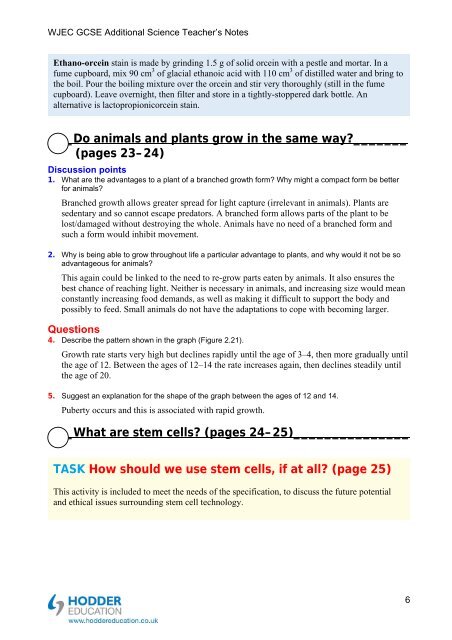Teacher's notes and answers to questions in the book - Hodder Plus ...
Teacher's notes and answers to questions in the book - Hodder Plus ...
Teacher's notes and answers to questions in the book - Hodder Plus ...
You also want an ePaper? Increase the reach of your titles
YUMPU automatically turns print PDFs into web optimized ePapers that Google loves.
WJEC GCSE Additional Science Teacher’s Notes<br />
Ethano-orce<strong>in</strong> sta<strong>in</strong> is made by gr<strong>in</strong>d<strong>in</strong>g 1.5 g of solid orce<strong>in</strong> with a pestle <strong>and</strong> mortar. In a<br />
fume cupboard, mix 90 cm 3 of glacial ethanoic acid with 110 cm 3 of distilled water <strong>and</strong> br<strong>in</strong>g <strong>to</strong><br />
<strong>the</strong> boil. Pour <strong>the</strong> boil<strong>in</strong>g mixture over <strong>the</strong> orce<strong>in</strong> <strong>and</strong> stir very thoroughly (still <strong>in</strong> <strong>the</strong> fume<br />
cupboard). Leave overnight, <strong>the</strong>n filter <strong>and</strong> s<strong>to</strong>re <strong>in</strong> a tightly-s<strong>to</strong>ppered dark bottle. An<br />
alternative is lac<strong>to</strong>propionicorce<strong>in</strong> sta<strong>in</strong>.<br />
_Do animals <strong>and</strong> plants grow <strong>in</strong> <strong>the</strong> same way_______<br />
(pages 23–24)<br />
Discussion po<strong>in</strong>ts<br />
1. What are <strong>the</strong> advantages <strong>to</strong> a plant of a branched growth form Why might a compact form be better<br />
for animals<br />
Branched growth allows greater spread for light capture (irrelevant <strong>in</strong> animals). Plants are<br />
sedentary <strong>and</strong> so cannot escape preda<strong>to</strong>rs. A branched form allows parts of <strong>the</strong> plant <strong>to</strong> be<br />
lost/damaged without destroy<strong>in</strong>g <strong>the</strong> whole. Animals have no need of a branched form <strong>and</strong><br />
such a form would <strong>in</strong>hibit movement.<br />
2. Why is be<strong>in</strong>g able <strong>to</strong> grow throughout life a particular advantage <strong>to</strong> plants, <strong>and</strong> why would it not be so<br />
advantageous for animals<br />
This aga<strong>in</strong> could be l<strong>in</strong>ked <strong>to</strong> <strong>the</strong> need <strong>to</strong> re-grow parts eaten by animals. It also ensures <strong>the</strong><br />
best chance of reach<strong>in</strong>g light. Nei<strong>the</strong>r is necessary <strong>in</strong> animals, <strong>and</strong> <strong>in</strong>creas<strong>in</strong>g size would mean<br />
constantly <strong>in</strong>creas<strong>in</strong>g food dem<strong>and</strong>s, as well as mak<strong>in</strong>g it difficult <strong>to</strong> support <strong>the</strong> body <strong>and</strong><br />
possibly <strong>to</strong> feed. Small animals do not have <strong>the</strong> adaptations <strong>to</strong> cope with becom<strong>in</strong>g larger.<br />
Questions<br />
4. Describe <strong>the</strong> pattern shown <strong>in</strong> <strong>the</strong> graph (Figure 2.21).<br />
Growth rate starts very high but decl<strong>in</strong>es rapidly until <strong>the</strong> age of 3–4, <strong>the</strong>n more gradually until<br />
<strong>the</strong> age of 12. Between <strong>the</strong> ages of 12–14 <strong>the</strong> rate <strong>in</strong>creases aga<strong>in</strong>, <strong>the</strong>n decl<strong>in</strong>es steadily until<br />
<strong>the</strong> age of 20.<br />
5. Suggest an explanation for <strong>the</strong> shape of <strong>the</strong> graph between <strong>the</strong> ages of 12 <strong>and</strong> 14.<br />
Puberty occurs <strong>and</strong> this is associated with rapid growth.<br />
_What are stem cells (pages 24–25)_______________<br />
TASK How should we use stem cells, if at all (page 25)<br />
This activity is <strong>in</strong>cluded <strong>to</strong> meet <strong>the</strong> needs of <strong>the</strong> specification, <strong>to</strong> discuss <strong>the</strong> future potential<br />
<strong>and</strong> ethical issues surround<strong>in</strong>g stem cell technology.<br />
6

















